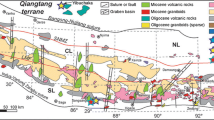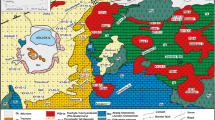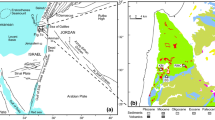Abstract
A suite of crustal xenoliths from Tertiary basaltic tuffs of the Northern Hessian Depression (NHD) volcanic field comprises abundant meta-igneous pyroxene granulites of mafic, noritic to anorthositic, IAT and tonalitic composition. Less abundant are granitic, tonalitic and leucogranitic gneisses and metasedimentary xenoliths. A total of 49 samples were analyzed for modal compositions, for major and trace elements (including Li, Rb, Sr, Ba, Cs, V, Sc, Cr, Co, Ni, Y, Zr, Nb, Ta, Hf, Th and REE) and oxygen isotopes. Two-pyroxene thermometry yields temperatures between 700 and 900° C for mafic and noritic granulites. Feldspar thermometry indicates temperatures of 660°–710° C for tonalitic granulites and 470°–520° C for granitic and tonalitic gneisses. One highly depleted sillimanite-rich metasediment contains cordierite and garnet which have equilibrated at temperatures of 780° C. The general lack of garnet in the mafic and noritic granulites and the presence of sillimanite in felsic xenoliths indicates that metamorphic pressures have not exceeded 10 kb. Major and trace element data and oxygen isotope compositions of the mafic granulites are compatible with an origin from spilitized enriched-type MORB rocks (enrichment in δ18O to 11‰ and in Li to 34 ppm at average SiO2 contents of 44.1 wt%). These low-T spilites were transformed into amphibolites and then pyroxene granulites during subsequent high temperature metamorphic events. Low Si, Al, K, and Rb concentrations along with An contents in plagioclase ranging from near 50 to 98 mole percent suggest that amphibolite facies protoliths have generated tonalitic melts during partial melting at temperatures above 700° C. The mafic granulite xenoliths are interpreted as restites whereas the tonalitic samples probably represent the extracted partial melts derived by 20 to 30 percent degree of melting. Metasedimentary xenoliths strongly depleted in granitic component could represent restites from which granitic S-type partial melts have been extracted. Tonalitic and leucogranitic gneisses including one trondhjemite xenolith have many chemical characteristics (e.g. REE distribution) in common with tonalite-trondhjemite-granodiorite suites of the North Atlantic region but cannot be accounted for a more specific origin. Estimated elastic properties of the main types of NHD xenoliths yield P-wave velocities of 6.0–6.4 km-1 for granitic, tonalitic and trondhjemite gneisses including tonalitic granulites and 6.5–7.0 for the more mafic xenoliths. When compared with two seismic depths-Vp profiles these data are in accordance with a model where the mafic, andesitic, noritic and tonalitic granulites comprise abundant rock types at depths between 29 km (Moho) and 20 km which mainly consists of old oceanic crust including subduction related volcanic products. The more felsic xenoliths probably represent material from depths between 12 and 20 km.
Similar content being viewed by others
References
Agrinier P, Javoy M, Girardeau J (1988) Hydrothermal activity in a peculiar oceanic ridge: oxygen and hydrogen isotope evidence in the Xigaze ophiolite (Tibet, China). Chem Geol 71:313–335
Allègre CJ, Minster FJ (1978) Quantitative models of trace element behavior in magmatic processes. Earth Planet Sci Lett 38:1–25
Barker F (1979) Trondhjemites: definition, environment and hypotheses of origin. In: Barker F (ed) Trondhjemites, dacites and related rocks. Dev Petrol 6: 1–12
Bernard-Griffiths, J Cornichet J (1985) Origin of eclogites from south Brittany, France: a Sm-Nd isotopic and REE study. Chem Geol 52:185–201
Bhattacharya A, Mazumdar AC, Sen SK (1988) Fe-Mg mixing in cordierite: constraints from natural data and implications for cordierite-garnet thermometry in granulites. Am Mineral 73:338–344
Bohlen SR, Mezger K (1989) Origin of granulite terranes and the formation of the lowermost continental crust. Science 244:329–329
Cameron WE, McCulloch MT, Walker DA (1983) Boninite petrogenesis: chemical and Nd-Sr isotopic constraints. Earth Planet Sci Lett 65:75–89
Davidson PM, Lindsley DH (1985) Thermodynamic analysis of quadrilateral pyroxenes. Contrib Mineral Petrol 91:390–404
Deer WA, Howie RA, Zussman J (1966) An introduction to the rock forming minerals. Longman, London
Deer WA, Howie RA, Zussman J (1978) Rock forming minerals, vol. 2A, single chain silicates, 2nd edn Longman, London
Deer WA, Howie RA, Zussman J (1982) Rock forming minerals, vol. 1A, orthosilicates, 2nd edn. Longman. London
Dupuy C, Leyreloup A, Vernieres F (1977) The lower continental crust of the Massif Central (Bournac, France) with special references to REE, U, and Th composition, evolution, heat flow production. In: Ahrens LH, Protas G (eds) Origin and distribution of the elements. Phys Chem Earth 11:401–415
Fallon TJ, Green DH (1986) Glass inclusions in magnesian olivine phenocrysts from Tonga: evidence for highly refractory parental magmas in the Tonga arc. Earth Planet Sci Lett 81:95–103
Fleet AJ, McKelney BC (1978) Eocene explosive submarine volcanism, Ninetyeast Ridge Indian Ocean. Marine Geol 26:73–97
Fuhrman ML, Lindsley DH (1988) Ternary-feldspar modelling and thermometry. Am Mineral 73:201–215
Fujimaki H, Tatsumoto M, Aoki K (1984) Partition coefficient of Hf, Zr, and REE between phenocrysts and groundmasses. Proc 14th Lunar Planet Sci Conf, Part 2, J Geophys Res 89:B662-B672
Gebrande H (1984) Elastic wave velocities and constants of elasticity of rocks and rock forming minerals. In: Landolt-Börnstein, New Series, vol. 1b, Physical properties of rocks. Springer, Berlin Heidelberg New York, pp 1–96
Goldsmith JR, Newton RC (1977) Scapolite-plagioclase stability relations at high pressures and temperatures in the system NaAlSi3O8−CaCO3−CaSO4. Am Mineral 62:1063–1081
Gorton MP (1977) The geochemistry and origin of Quaternary volcanism in the New Hebrides. Geochim Cosmochim Acta 41:1257–1271
Graham CM, Harmon RS (1983) Stable isotope evidence on the nature of crust mantle interactions. In: Hawkesworth CJ, Norry MJ (eds) Continental basalts and mantle xenoliths. Shiva Geology Series, Nantwich, pp 20–45
Green DH, Ringwood AE (1967) An experimental investigation of the gabbro to eclogite transformation and its petrological applications. Geochim Cosmochim Acta 31:767–833
Haenel R (1983) Geothermal investigations in the Rhenish Massif. In: Fuchs K, von Gehlen K, Mälzer H, Murawski H, Semmel A (eds) Plateau Uplift, the Rhenish Massif—A case history. Springer, Berlin Heidelberg New York, pp 228–246
Haskin LA, Haskin MA, Frey FA, Wildeman TR (1968) Relative and absolute terrestrial abundances of the rare earths. In: Ahrens LH (ed) Origin and distribution of the elements. 1. Pergamon, Oxford, pp 889–911
Helz RT (1973) Phase relations of basalts in their melting range at PH20=5 kb as a function of oxygen fugacity. Part I Mafic phases. J Petrol 14:249–302
Helz RT (1976) Phase relations of basalts in their melting range at PH20=5 kb. Part II Melt compositions. J Petrol 17:139–193
Henderson P (1983) General geochemical properties and abundances of the rare earth elements. In: Henderson P (ed) Rare earth element geochemistry. Developments in Geochemistry 2. Elsevier, Amsterdam, pp 1–32
Hodges KV, McKenna LW (1987) Realistic propagation of uncertainties in geologic thermobarometry. Am Mineral 72:671–680
Hofmann AW (1988) Chemical differentiation of the Earth: the relationship between mantle, continental crust, and oceanic crust. Earth Planet Sci Lett 90:297–324
Holdaway MJ (1971) Stability of andalusite and the aluminium silicate phase diagram. Am J Sci 271:97–131
Huang WL, Wyllie PJ (1986) Phase relations of gabbro-tonalitegranite-water at 15 kb with application to differentiation and anatexis. am Mineral 71:301–316
Huckenholz HG, Seiberl WM (1988) Stabilität und Phasenbeziehungen von Karbonatskapolith in Gegenwart einer H2O−CO2-Gasphase. Fortschr Mineral 66:72
Jäger E (1977) The evolution of the central and west European continent. Coll Intern CNRS Rennes 243:227–239
Johannes W (1984) Beginning of melting in the system Qz−Or−Ab−An−H2O. Contrib Mineral Petrol 86:264–273
Johnston AD, Wyllie PJ (1988) Constraints on the origin of Archean trondhjemites based on phase relationships of Nuk gneiss with H2O at 15 kb. Contrib Mineral Petrol 100:35–46
Kern H, Schenk V (1985) Elastic wave velocities from a lower crustal section in southern Calabria (Italy). Phys Earth Planet Int 40:147–160
Kushiro I (1982) Density of tholeiitic and alkaline magmas at high pressures. Annual Rep Director Geophys Lab Washington Yearb 81:305–309
Kushiro I, Yoder HS (1966) Anorthite-forsterite and anorthiteenstatite reactions and their bearing on the basalt-eclogite transformation. J Petrol 7:337–362
Kyser TK, Cameron WE, Nisbet EG (1986) Boninite petrogenesis and alteration history: constraints from stable isotopes of boninites from Cape Vogel, New Caledonia and Cyprus. Contrib Mineral Petrol 93:222–226
Le Maittre RW (1979) A new generalized petrogenetic mixing model. Contrib Mineral Petrol 71:133–129
Le Roex AP, Dick HJB, Erlank AJ, Reid AM, Frey FA, Hart SR (1983) Geochemistry and petrogenesis of lavas erupted along the Southwest Indian Ridge between the Bouvet triple junction and 11 degrees east. J Petrol 24:267–318
Liew TC, Hofmann AW (1988) Precambrian crustal components, plutonic associations, plate environment of the Hercynian fold belt of central Europe: indications from a Nd and Sr isotopic study. Contrib Mineral Petrol 98:129–138
Lindsley DH (1983) Pyroxene thermometry. Am Mineral 68:477–493
Martin H (1987) Petrogenesis of Archean trondhjemites, tonalites, and granodiorites from Eastern Finland: major and trace element geochemistry. J Petrol 28:921–953
Matsui Y, Onuma N, Nagasawa H, Higuchi H, Banno S (1977) Crystal structure control in trace element partion between crystals and magma. Bull Soc Fr Mineral Cristallogr. 100:315–324
Mechie J, Prodehl C, Fuchs K (1983) The long-range seismic refraction experiment in the Rhenish Massif. In: Fuchs K, von Gehlen K, Gehlen K, Mälzer H, Murawski H, Semmel A (eds) Plateau Uplift, the Rhenish Massif. A case history. Springer, Berlin Heidelberg New York, pp 260–275
Mehnert KR (1975) The Ivrea Zone. A model for the deep crust. Neues Jahrb Mineral Abh 125:156–199
Mengel K (1983) Petrographie und Geochemie der Tuffe des Habichtswaldes und seiner Umgebung Nördliche Hessische Senke. Neues Jahrb Mineral Abh 147:1–20
Mengel K, Wedepohl KH (1983) Crustal xenoliths in Tertiary volcanics from the Northern Hessian Depression. In: Fuchs K, von Gehlen K, Mälzer H, Murawski H, Semmel A (eds) Plateau Uplift, the Rhenish Massif. A case history. Springer, Berlin Heidelberg New York, pp 332–335
Mengel K, Borsuk AM, Gurbanov AG, Wedepohl KH, Baumann A, Hoefs J (1987) Origin of spilitic rocks from the southern slope of the Greater Caucasus. Lithos 20:115–133
Mengel K, van Calsteren P (1989) Charakterisierung proterozoischer Unterkruste im Basement NW-Deutschlands. Europ J Mineral 1 Beih. 1:120
Mengel K, Hoefs J, Watson J (1989) Geochemistry of crustal xenoliths from the Northern Hessian Depression Tertiary volcanic field (West Germany). Terra Abstr. 1:320
Michael PJ (1988) The concentration, behavior and storage of H2O in the suboceanic upper mantle: implications for mantle metasomatism. Geochim Cosmochim Acta 52:555–566
Nakamura N (1974) Determination of REE, Ba, Fe, Mg, Na, and K in carbonaceous and ordenary chondrites. Geochim Cosmochim Acta 38:757–775
Newton RC (1983) Geobarometry of high grade metamorphic rocks. Am J Sci 283-A:1–28
Okrusch M, Schröder B, Schnütgen A (1979) Granulite facies metabasite ejecta in the Laacher See area, Eifel, West Germany. Lithos 12:251–270
Pearce JA (1983) Role of sub-continental lithosphere in magma genesis at active continental margins. In: Hawkesworth CJ, Norry MJ (eds) Continental basalts and mantle xenoliths. Shiva Geology Series, Nantwich, pp 230–249
Peucat JJ, Vidal P, Godard G, Postaire B (1982) Precambrian U-Pb zirkon ages in eclogites and garnet pyroxenites from south Brittany (France): an old oceanic crust in the west European Hercynian belt. Earth Planet Sci Lett 60:70–78
Peucat JJ, Jegouzo P, Vidal P, Bernard-Griffiths J (1988) Continental Crust formation seen through the Sr and Nd isotope systematics of S-type granites in the Hercynian belt of western France. Earth Planet Sci Lett 88:60–68
Pollack HN, Chapman DS (1977) On the regional variation of heat flow, geotherms and lithospheric thickness. Tectonophysics 38:279–296
Potts PJ, Webb PC, Watson JS (1984) Energy dispersive X-Ray fluorescence analysis of silicate rocks for major and trace elements. X-Ray Spectrometry 13:2–15
Richardson SW, Gilbert MC, Bell PM (1969) Experimental determination of cyanite-andalusite and andalusite-sillimanite equilibria: the aluminium silicate triple point. Am J Sci 267:259–272
Ringwood AE (1975) Composition and petrology of the Earth's mantle. McGraw-Hill, New York, pp 11–34
Rollinson HR, Windley BF (1980) An Archean granulite-grade tonalite-trondhjemite-granite suite from Scourie, NW Scotland: geochemistry and origin. Contrib Mineral Petrol 72:265–281
Rushmer T (1989) Granulites as residues of partial melting: experimental constraints. Terra abstr 1:302
Ryan JG, Langmuir CH (1987) The systematics of lithium abundances in young volcanic rocks. Geochim Cosmochim Acta 51:1727–1741
Sachs PM (1988) Untersuchungen zum Stoffbestand der tieferen Lithosphäre an Xenolithen südwestdeutscher Vulkane. Ph D Dissertation, Universität Stuttgart
Scarfe CM (1973) Water solubility in basic and ultrabasic magmas. Nature 246:9–10
Schnetger B (1988) Geochemische Untersuchungen an den Kinzigiten und Stronaliten der Ivrea-Zone, Nord-Italien. Ph D Dissertation Universität Göttingen
Schulz-Dobrick B (1975) Chemischer Stoffbestand variskischer Geosynklinalablagerungen in Rhenoherzynikum. Ph D Dissertation, Universität Göttingen
Schwarzmann S (1957) Über Feldspat-und Feldspatgesteins-fremdlinge in den Tertiärvulkanen des Oberweser-Fulda-Gebietes. Abh Akad Wiss Göttingen Math Natur Kl 3. Folge 25:1–165
Shaw DM, Vatin-Pergnon N, Muysson JR (1977) Lithium in spilites. Geochim Cosmochim Acta 41:1601–1607
Spooner ETC, Beckinsale RD, England PC, Senior A (1977) Hydration, 18O enrichment and oxidation during ocean floor hydrothermal metamorphism of ophiolitic metabasic rocks from Liguria, Italy. Geochim Cosmochim Acta 41:857–871
Stoffyn-Egli P, Mackenzie FT (1984) Mass balance of dissolved lithium in the oceans. Geochim Cosmochim Acta 48:859–872
Stosch HG, Lugmair GW (1984) Evolution of the lower continental crust: granulite facies xenoliths from the Eifel, West Germany. Nature 311:368–370
Tatsumi Y, Ishizaka K (1982) Origin of high-magnesian andesites from the Setouchi volcanic belt, Southwest Japan, I. Petrographical and chemical characteristics. Earth Planet Sci Lett 60:293–304
Thompson G, Bryan WB, Frey FA, Dickey JS (1978) Basalts and related rocks from Deep-Sea Drilling sites in the Central and Eastern Indian Ocean. Marine Geol 26:119–138
Voll G (1983) Crustal xenoliths and their evidence for crustal structure underneath the Eifel volcanic district. In: Fuchs K, von Gehlen K, Mälzer H, Murawski H, Semmel A (eds) Plateau Uplift, the Rhenish Massif—A case history. Springer, Berlin Heidelberg New York, pp 336–342
Walter R, Meyer W (1986) Structure and development of the Variscan zones: Rhenohercynian. In: Freeman R, Mueller St, Gies P (eds) Proceedings of the third workshop on the European Geotraverse Project (EGT). European Science Foundation, Strasbourg, pp 127–133
Wedepohl KH (1975) The contribution of chemical data to assumptions about the origin of magmas from the mantle. Fortschr Mineral 52:141–172
Wedepohl KH (1981) Tholeiitic basalts from spreading ocean ridges. The growth of the oceanic crust. Naturwissenschaften 68:110–119
Wedepohl KH (1983) K-Ar-Altersbestimmungen an basaltischen Vulkaniten der nördlichen Hessischen Senke und ihr Beitrag zur Diskussion der Magmengenese. Neues Jahrb Mineral Abh 144:172–169
Wedepohl KH (1985) Origin of Tertiary basaltic volcanism in the Northern Hessian Depression. Contrib Mineral Petrol 89:122–143
Wedepohl KH (1988) Spilitization in the ocean crust and seawater balances. Fortschr Mineral 66:129–146
Wells PRA (1977) Pyroxene thermometry in simple and complex systems. Contrib Mineral Petrol 62:129–139
Wood BJ (1986) Thermodynamics of multicomponent systems containing several solid solutions. In: Carmicheal ISE, Eugster HP (eds) Reviews in Mineralogy Vol 17, Thermodynamic modeling of geological material. Mineralogical Society of America, pp 88–94
Wolf MB, Wyllie PJ (1989) The formation of tonalitic liquids during the vapor-absent melting of amphibolite at 10 kb. EOS 70, 15:225–528
Wörner G, Schmincke HU, Schreyer W (1982) Crustal xenoliths from the Quaternary Wehr volcano (East Eifel). Neues Jahrb Mineral Abh 144:29–55
Author information
Authors and Affiliations
Rights and permissions
About this article
Cite this article
Mengel, K. Crustal xenoliths from Tertiary volcanics of the Northern Hessian Depression. Contr. Mineral. and Petrol. 104, 8–26 (1990). https://doi.org/10.1007/BF00310642
Received:
Accepted:
Issue Date:
DOI: https://doi.org/10.1007/BF00310642




